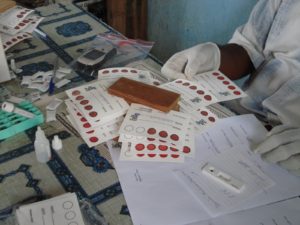
Without diagnostic tests, medicine is blind. And yet, diagnostics receive much less attention than vaccines and drugs. Imagine a sick infant with bacterial sepsis in sub-Saharan Africa. Without diagnostics, they will likely get incorrectly treated for malaria. Every year, one million patients with TB in India are either not diagnosed or not reported. Pregnant women with anaemia, syphilis, and diabetes are often missed in low income countries where laboratory capacity is severely lacking. And where there is available testing, it is often of low quality.
A recent NEJM article proposed a simple way to improve access to critical diagnostics: make a list. In 1977, the World Health Organization (WHO) started (and has since maintained) a Model List of Essential Medicines (EML). The EML, a global health success, has improved access to medicines. Sadly, there is no equivalent Model List of Essential Diagnostics (EDL). Such a list would be impactful for these reasons:
1) Improve patient care and clinical outcomes
Patients will get consistent access to quality essential diagnostics that will be affordable and always available. When a diagnostic is added to an EDL, governments, funders, and manufacturers will work to ensure availability and access.
2) Help detect emerging infectious threats
The Ebola and Zika epidemics have underscored the need for surveillance. While many countries have reference laboratories, laboratory capacity at lower health system tiers is often weak. By increasing laboratory capacity at all tiers, an EDL could help countries better prepare for epidemics and implement international health regulations.
3) Increase affordability
Bulk and advanced purchasing, volume discounts, and pooling mechanisms are widely used for vaccines and drugs. Without such mechanisms, quality diagnostics can be unaffordable. Xpert MTB/RIF is a good TB test, but affordability is limited. An EDL could promote group purchasing by international organisations (for example, the Global Fund). With larger, predictable volumes, manufacturers can lower prices. Countries can use EDL to impose price controls, and waive import duties to ensure affordability.
4) Reduce antimicrobial resistance (AMR)
Indiscriminate antimicrobial use drives AMR. Without adequate diagnosis, antimicrobials get widely abused. In half of the African countries where malaria is endemic over 80% of malaria treatments are applied without diagnostic testing, leading to legitimate concern for the emergence of drug resistance.
5) Improve regulation and quality of diagnostics
Unlike developed countries, regulatory agencies that approve the accuracy of diagnostic devices either do not exist or are weak in resource poor settings. An EDL could focus such agencies on priority tests and help to harmonise regulation at the regional level. An EDL could aid in the identification of sub-standard diagnostics, as is already occurring for malaria rapid tests.
6) Facilitate laboratory accreditation and training
Even if a diagnostic test is of high quality, its impact can be crippled by improper use. In Kampala, Uganda, 95% of all laboratories failed to get the lowest score on the WHO laboratory quality checklist. Country level laboratory accreditation groups could use the EDL to establish targeted and appropriate quality assurance programs. An EDL could also help shape in-country training of laboratorians.
7) Improve supply chain and laboratory infrastructure
As is too often the case in low income settings, poor infrastructure and inconsistent supply chains render laboratory devices unusable. An EDL could encourage ministries of health to strengthen necessary infrastructures and develop targeted supply chains for the essential tests.
8) Facilitate change in healthcare provider behaviour
Healthcare professionals trained in countries where laboratory testing is either unavailable or of low quality are likely to treat based on clinical suspicion. The impact of the Xpert MTB/RIF TB test has been blunted because of such issues. Likewise, in several settings, providers continue to give antimalarial therapies, despite negative rapid test results. An EDL could improve providers’ confidence in test results, and strengthen the diagnostic-treatment cascade.
9) Inform new technology development
Several teams are now developing point of care diagnostics for global health. An EDL could help develop target product profiles that can inform new product development. In fact, such initiatives already exist for several key diagnostics.
10) Facilitate epidemiological surveys, programme evaluation, and disease elimination
Policymakers need data on disease burden. An EDL could support national surveys and help track changes in disease burden and the efficacy of interventions (for example, diagnostics to support polio elimination).
Essential medicines require essential diagnostics. The NEJM article has proposed an EDL to set the ball rolling. While many agencies could establish an EDL, WHO is the obvious choice, since they maintain the EML, make health policies, run prequalification programmes, and oversee international health regulations.
So, we call on WHO to take the lead in creating a List of Essential Diagnostics. We also call on key stakeholders (for example, FIND, PATH, TDR, CHAI, GLI, ASLM, GHTC, Stop TB Partnership, Roll Back Malaria, UNAIDS), civil society (for example, MSF, TAG, ACTION), and donors (for example, Global Fund, Bill & Melinda Gates Foundation, UNITAID, USAID) to support WHO to make this happen.
Lee Schroeder is assistant professor at the University of Michigan where he is director of point of care testing and associate director of chemical pathology. Twitter: @leefschroeder
Timothy Amukele is an assistant professor at the Johns Hopkins University School of Medicine where he is the director of the Bayview Medical Center Clinical Laboratories. He is also the medical director of the Makerere University-Johns Hopkins University laboratory in Kampala, Uganda. Twitter: @TimAmukele
Madhukar Pai is a Canada research chair in epidemiology & global health at McGill University, Montreal, Canada. He serves as the director of McGill Global Health Programs, and associate director of the McGill International TB Centre. Twitter: @paimadhu
Authors’ competing interests: None declared.
This blog was first published on www.forbes.com.